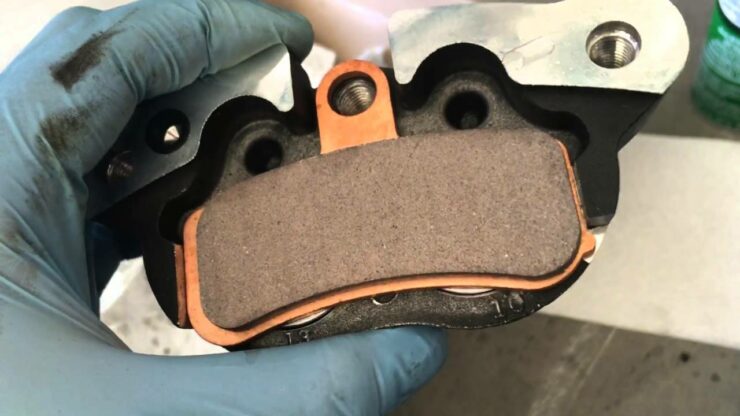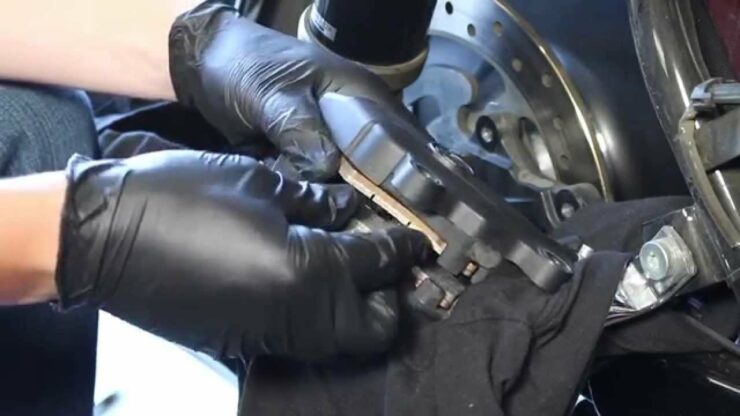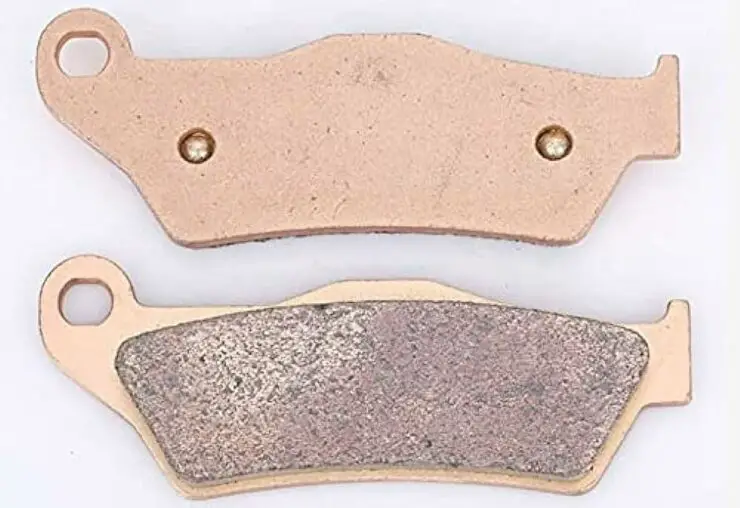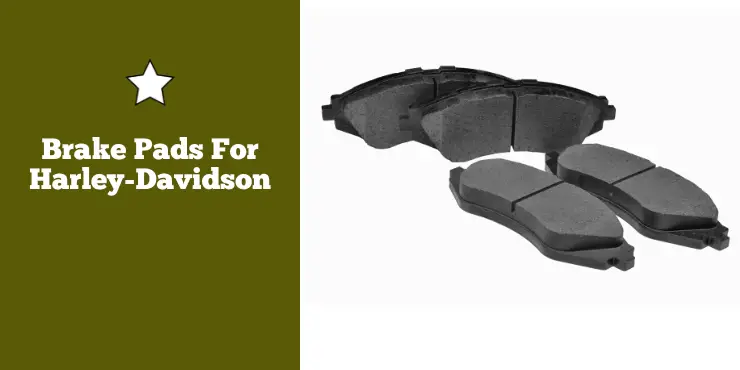Are you ready to hit the open road on your Harley-Davidson, but want to make sure you have the best brake pads to keep you safe?
Harley-Davidson brake pads, including OEM and brands like EBC and Lyndall, offer durable stopping power. Choose sintered pads for heavy-duty use or organic pads for smoother, quieter stops.
In this article, we will delve into the world of brake pads specifically designed for Harley-Davidson motorcycles. Whether you’re a seasoned rider or new to the motorcycle scene, having reliable and high-performing brake pads is essential to ensure your safety and the longevity of your bike. Read on to discover everything you need to know about choosing the right brake pads for your Harley-Davidson.
What do Harley-Davidson Brake Pads do?
Harley-Davidson bikes are synonymous with power and freedom when driving on the open road. However, with great power comes the need for great control. Brake pads are an important component in your bike’s braking system, playing a key role in ensuring your safety during every ride.
>>> Click here to read our review of the Best Break Pads For Harley-Davidson <<<
Brake pads are vital components of your Harley-Davidson bike’s braking system that create the friction necessary to slow down or stop the wheels from spinning. They’re designed as rectangular or oval-shaped plates made from high-friction materials, typically composite materials or organic compounds. When you squeeze the brake lever, the brake pads get pressed against the rotating disc (rotor), creating the friction required to slow down or stop the bike.

Brake pads are at the heart of your bike’s stopping power and their role is important for various reasons. If you’re wondering what do Harley-Davidson brake pads do, then here are some of their uses –
#1. Friction generation
When you apply the brakes, hydraulic pressure from the brake master cylinder pushes the brake caliper pistons, which in turn squeeze the brake pads against the spinning disc brake. This contact generates friction, converting the kinetic energy of your moving bike into heat, slowing it down, or bringing it to a stop.
#2. Control and maneuverability
Brake pads deliver precise control over your bike’s speed and maneuverability. The gradual application of bake force will allow you to modulate your braking, whether you are cruising, cornering, or coming to a full stop. This control is important for safe and enjoyable riding.
#3. Safety
Perhaps the most critical role of brake pads is ensuring your safety on the road. Effective brake pads reduce your stopping distance, allowing you to respond quickly to unexpected situations and avoid accidents. Well-maintained brake pads are important for emergency stops and maintaining a safe following distance from other vehicles.
#4. Provide durability to the bike
Harley-Davidson bikes are known for their heavyweight and powerful engines. Brake pads help the bike withstand the immense forces generated by these machines. High-quality brake pads are designed for durability, providing consistent and reliable performance under various riding conditions.
Different types of brake pads for Harley-Davidson bikes
As a Harley-Davidson rider, you will want your bike to constantly deliver the power and performance these bikes are known for. To ensure your bike stops as impressively as it accelerates, choosing the right brake pads will be important. There are different types of Harley-Davidson brake pads and knowing your options will help you pick the right one. Here are the different types of brake pads for Harley-Davidson bikes.
Organic Brake Pads
Organic brake pads, often referred to as non-metallic or organic fiber brake pads are composed of a mix of organic materials like rubber, glass, and aramid fibers bonded together with resins. This composition produces a softer and more versatile brake pad.
Organic brake pads offer a smooth braking experience, making them perfect for riders who prioritize comfort. They offer great stopping power for everyday city commuting and general riding situations.
These brake pads tend to wear out faster than ceramic or sintered pads, especially under heavy braking conditions. In extreme heat or during aggressive riding, these pads can experience brake fade, reducing their effectiveness.
Ceramic Brake Pads
Ceramic brake pads are composed of ceramic fibers, bonding agents, and other filler materials. These brake pads are known for their dense and durable construction. These brake pads produce minimal brake dust, keeping the wheels cleaner and reducing maintenance.
You can expect consistent performance across a wide range of temperatures, which makes them suitable for various riding conditions. However, they can be slightly more expensive than organic counterparts. Some riders might find ceramic pads to have a slightly less aggressive initial bite compared to other types.
Sintered Brake Pads
Sintered brake pads are crafted from a mix of metallic particles that are fused together under high heat and pressure. These brake pads are known for their durability and toughness. They’re capable of withstanding high temperatures and heavy use, which makes them ideal for aggressive riding or heavy motorcycles.
They provide consistent performance in demanding conditions like off-road or wet-weather riding. Sintered brake pads can be noisier and more abrasive, which results in faster rotor wear. Some riders might find them to have a more aggressive initial bite, which can take some getting used to.

Pros and cons of Organic Brake Pads
To ensure your safety and continue getting amazing braking performance from your Harley-Davidson bike, investing in the right type of brake pads is essential. Among the different options available, Organic Brake Pads are among the best choices if you’re looking for smooth and quiet performance. However, they aren’t perfect and have their drawbacks as well. Here are some of the pros and cons of Organic Brake Pads.
Here are some of the pros of Organic Brake Pads for Harley-Davidson bikes –
#1. Smooth and quiet operation
One of the biggest benefits of organic brake pads is their smooth and quiet operation. When you apply the brakes, they offer a gentle and consistent braking experience, enhancing overall rider comfort.
#2. Ideal for city riding
Organic brake pads are suited for everyday city riding commuting and general riding conditions. They offer adequate stopping power for typical traffic situations and provide a reliable and predictable feel at the brake lever.
#3. Cost-effective
Organic brake pads are often more budget-friendly compared to other types of brake pads. This makes them an attractive option for riders who want reliable performance without breaking the bank.
#4. Eco-friendly
These brake pads are composed of organic materials like glass, rubber, and aramid fibers, which are less harmful to the environment compared to the metallic components in other brake pads.
Here are some of the cons of Organic Brake Pads for Harley-Davidson bikes –
#1. Wear rate
Organic brake pads wear down faster than other types of brake pads. This is especially the case under heavy braking conditions or for riders who frequently ride in mountainous terrain. This means you might have to replace them more often.
#2. Brake fade
In extreme heat or during aggressive riding, organic brake pads can experience brake fade. Brake fade usually occurs when the brake pads become less effective at generating friction, resulting in reduced stopping power. This phenomenon can be a concern for riders who engage in spirited or high-performance riding.
#3. Less initial bite
Some riders may find that organic brake pads have a slightly less aggressive initial bite compared to other types of braking pads. This means you may have to apply more pressure to the brake lever to achieve the same level of braking force.
#4. Not suited for heavy bikes
Organic brake pads might not be the ideal choice for heavy Harley-Davidson models, especially those equipped with larger engines. These motorcycles generate greater momentum and might require more substantial braking power.
Pros and cons of Ceramic Brake Pads
Ceramic Brake Pads are another popular type of brake pads for Harley-Davidson bikes. These brake pads are known for their low dust and consistent performance. However, these brake pads come with their own set of benefits and drawbacks. You will need to know both sides of the coin to decide if they’re ideal for you.
Here are some of the pros of Ceramic Brake Pads for Harley-Davidson bikes –
#1. Low brake dust
One of the advantages of ceramic brake pads is their ability to produce minimal brake dust. This characteristic keeps the wheels cleaner and reduces the need for frequent cleaning and maintenance.
#2. Consistent performance
Ceramic brake pads offer consistent braking performance across a wide range of temperatures. Whether you are riding in scorching heat or chilly weather, you can expect these brake pads to provide dependable stopping power.
#3. Reduced noise
Ceramic brake pads are quieter than organic brake pads. This quieter operation contributes to a more enjoyable and comfortable riding experience.
#4. Longer lifespan
Ceramic brake pads are known for their durability. These brake pads typically have a longer lifespan than organic brake pads, which means you will have to replace them less often.
Here are some of the cons of Ceramic Brake Pads for Harley-Davidson bikes –
#1. High cost
Ceramic brake pads are more expensive than their organic counterparts. While they do offer long-term value due to their extended lifespan, the initial investment can be quite high.
#2. Low initial bite
Some riders might feel that these brake pads offer a slightly less aggressive initial bite. This means you’re left with no option but to apply more pressure to the brake lever to achieve the same level of braking force. This can take some getting used to.
#3. Rotor wear
Ceramic brake pads can be abrasive, potentially causing faster wear on the brake rotors. While this can be a trade-off for their consistent performance, it might lead to increased maintenance costs over time.
#4. Limited for extreme performance
For riders who engage in high-performance or aggressive riding, ceramic brake pads might not offer the same level of heat resistance as sintered pads. In extreme conditions, they can experience brake fade, reducing their effectiveness.
Pros and cons of Sintered Brake Pads
Harley-Davidson bikes are known for their formidable power and distinctive style. When it comes to the braking system, selecting the right brake pads is important for safe and effective stopping. Sintered brake pads have gained massive popularity among riders looking for durability and high-performance braking. However, they also come with their fair share of drawbacks.
Here are some of the pros of Sintered Brake Pads for Harley-Davidson bikes –
#1. Exceptional durability
Sintered brake pads are known for their durability and longevity. They’re engineered to withstand high levels of heat and friction, making them suited for demanding riding conditions.
#2. Consistent performance
Sintered brake pads offer consistent and reliable performance across a wide range of temperatures and riding situations. Whether you are cruising, touring, or tackling challenging terrain, sintered brake pads offer dependable stopping power.
#3. High heat tolerance
Sintered brake pads are capable of handling extreme heat without experiencing brake fade, a phenomenon where braking effectiveness diminishes due to overheating. This heat tolerance is especially advantageous for riders who engage in spirited or high-performance riding.
#4. Suitable for heavy bikes
Harley-Davidson bikes, especially those with larger engines, can be heavy. These brake pads are suited for heavy bikes, ensuring that they can generate the necessary stopping force to safely bring your bike to a halt.
Here are some of the cons of Sintered Brake Pads for Harley-Davidson bikes –
#1. Excessive noise and vibration
Sintered brake pads can be noisier than other types, producing a characteristic squeal or squeak when you apply the brakes. Some riders find this noise to be unsettling or unpleasant.
#2. Abrasive nature
Due to their abrasive composition, sintered brake pads can wear down brake rotors faster than organic or ceramic pads. This might result in increased maintenance costs over time.
#3. Excessive initial bite
These pads have a more aggressive initial bite compared to other types of brake pads. This means that they can feel grabby or sensitive when you first apply the brakes, which might require some adjustment in your braking technique.
#4. Cost
Sintered brake pads are typically much more expensive than their organic counterparts. While they do offer superior performance and durability, the initial investment can be higher.
Factors to consider when choosing brake pads for your Harley-Davidson bike
When it comes to safety and performance, your choice of brake pads plays a pivotal role. To ensure your Harley-Davidson bike stops as impressively as it roars, it is important to consider various factors when selecting brake pads. Here are some of the factors to consider when choosing the right brake pads for your Harley-Davidson bike.
Riding style
If your Harley-Davidson bike is primarily used for leisurely cruising or city commuting, you might prioritize smooth and comfortable braking. Organic or ceramic brake pads are suited for this riding style, offering quiet and consistent stopping power.
For riders who love spirited or high-performance riding, sintered brake pads are a great choice. They provide exceptional stopping power and heat tolerance, ensuring consistent performance during intense braking.
Harley-Davidson model and year
If you own a heavy Harley-Davidson model, especially ones with larger engines, you should consider sintered brake pads. They’re capable of generating the necessary stopping force to safely bring your bike to a halt.
Vintage Harley-Davidson bikes might have unique brake systems. Make sure that the brake pads you select are compatible with your bike’s model and year, as some older bikes might require specialized pads.
Brake and performance
Choose organic pads for smooth and quiet braking as they’re ideal for leisurely rides and city commuting. These brake pads are cost-effective and gentle on brake rotors but might wear down faster under heavy use.
Opt for ceramic pads if you value low dust, consistent performance, and reduced noise. They are suited for various riding conditions but might come at a slightly higher initial cost.
Select sintered pads if you demand high-performance stopping power and exceptional durability. They excel in challenging conditions but might produce noise and accelerate rotor wear.
Durability
While organic and ceramic pads offer comfort and low dust, they might have a shorter lifespan than sintered pads. You should consider your riding habits and the need for frequent pad replacements when making your choice.
Sintered pads are known for their durability and resistance to extreme heat and heavy use. If longevity is a priority, especially for riders who log extensive miles, sintered pads are a great investment.
Budget
Organic pads are often budget-friendly, which makes them a cost-effective choice for riders who want reliable performance without a significant upfront expense.
While ceramic pads might have a slightly higher initial cost, their long lifespan and consistent performance offer long-term value.
Sintered pads are much more expensive but their exceptional durability and high-performance capabilities justify the investment for riders who demand the best.

Maintenance tips to prolong the lifespan of Harley-Davidson Brake Pads
One of the most important aspects of performance in your Harley-Davidson bike is the braking system. Harley-Davidson brake pads play a major role in determining the stopping performance of your bike. To ensure your bike’s brake pads last as long as possible, regular maintenance will be important. Here are some of the maintenance tips that will help extend the lifespan of your brake pads, preserving the stopping power of your bike for the long haul.
Regular inspection and cleaning
Regularly inspecting your brake pads is important to catch any signs of wear or damage early. Look for visible signs of wear on your brake pads. If they’re getting thin or if you see deep grooves or cracks, it’ll be time to replace them.
Dirt and debris can accumulate on your brake pads, reducing their effectiveness and causing premature wear. Use a soft brush or compressed air to clean your brake pads and remove any buildup.
Monitor brake fluid levels
Proper brake fluid levels are important for maintaining effective braking performance. Regularly inspect the brake fluid reservoir to make sure it’s filled to the recommended level. Low brake fluid can lead to reduced brake pad contact and compromised braking power.
Harley-Davidson recommends you replace braking fluid once every two years to maintain optimal performance. Old brake fluid can lead to brake fade and reduced brake pad lifespan.
Proper brake usage
How you use your brakes significantly impacts the lifespan of your brake pads. You should avoid any abrupt or hard braking when possible. Gradual, smooth braking will minimize the stress on your brake pads and extend their life.
Utilize engine braking by downshifting gears when appropriate. This will reduce the reliance on your brakes and help them last longer. Moreover, you should plan your stops in advance by looking ahead and anticipating traffic conditions. This will allow you to use your brakes more sparingly.
Avoid overheating
Overheating can result in brake pad deterioration and reduced effectiveness. If you are riding downhill or through hilly terrain, avoid constant and prolonged braking. Give your brakes time to cool down between uses.
Downshifting to lower gears can help you slow down without excessive use of brakes, which reduces the risk of overheating. Heavy braking, especially during aggressive riding or challenging conditions, will allow your brakes to cool down by riding at a reduced speed without using the brakes excessively.
FAQs
What are the best brake pads for Harley-Davidson motorcycles?
The best brake pads for Harley-Davidson motorcycles will depend on a few factors, such as your riding style, the specific model of your Harley, and your personal preferences. It is recommended to look for brake pads specifically designed for Harley-Davidson motorcycles for optimal performance.
How often do brake pads need to be replaced on a Harley-Davidson?
The frequency of brake pad replacement on a Harley-Davidson will vary depending on several factors, including your riding habits, the mileage you cover, and the condition of the brake pads. Typically, brake pads need to be replaced every 10,000 to 30,000 miles, but it is essential to regularly inspect the pads for wear and tear and replace them promptly if they appear worn down.
Are there any specific signs that indicate it’s time to replace the brake pads on a Harley-Davidson?
Yes, there are several signs to look out for that indicate it’s time to replace the brake pads on a Harley-Davidson. These signs include squeaking or squealing noises when applying the brakes, reduced braking performance, increased stopping distance, vibration or pulsation in the brake pedal, or visual inspection revealing thin brake pad material. If you experience any of these signs, it is recommended to replace the brake pads as soon as possible for safety reasons.
>>> Read more about Harley-Davidson Parts & Maintenance <<<

